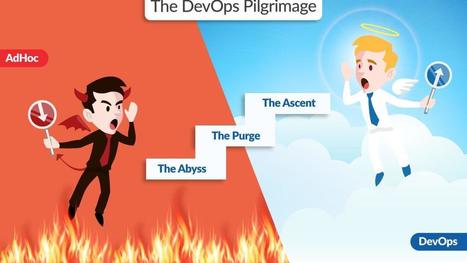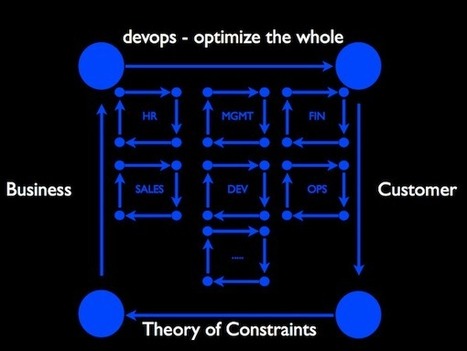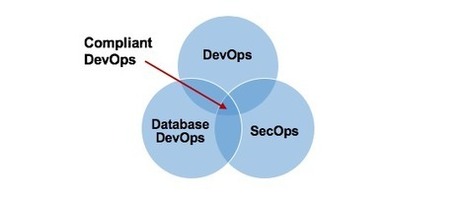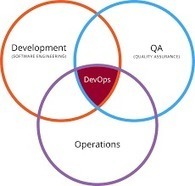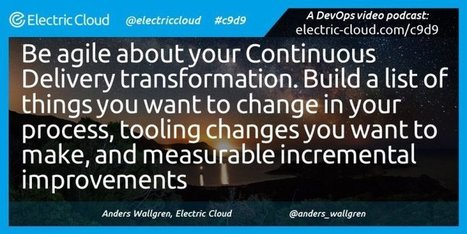 Your new post is loading...
 Your new post is loading...

|
Scooped by
Mickael Ruau
July 17, 2020 4:54 AM
|
Here's Part 3 of The DevOps Pilgrimage blog that leads to the Ascent with functional testing of fresh deployment and upgrade. Click here to learn more.

|
Scooped by
Mickael Ruau
July 17, 2020 4:46 AM
|
In series of posts at Agile Gnostic, I explained about the four facets to agility. These four facets of Agile are... Values and Principles Culture & Mindset Methods & Practices Tools and Technologies What I observed is that all these four facets are applicable to DevOps as well. This post introspects these facets from DevOps…

|
Scooped by
Mickael Ruau
July 15, 2020 11:45 AM
|
A water spider is a Lean production personnel role centered around timely and accurate stock replenishment. The water spider team member is much like a mobile Kanban system that refills the production line with the required materials to maintain a steady flow.
The person filling a water spider position needs to have a good understanding of the process, excellent communication skills, and has got to be able to follow standardized routes.
The water spider term was inspired by an insect known as a whirligig beetle, Mizusumashi in Japanese. Whirligigs appear to be able to hang between the water and the air while quickly going from place to place, keeping both of the environments in their sight simultaneously. How a water spider stock manager moves about the production floor, and the way they perceive all production steps at once, resembles the beetle’s movements and sight, giving the role its name.

|
Scooped by
Mickael Ruau
July 14, 2020 2:20 AM
|
The Phoenix Project: A Novel About IT, DevOps, and Helping Your Business Win by Gene Kim, Kevin Behr, George Spafford My rating: 4 of 5 stars This book is in a story form following someone who has …

|
Scooped by
Mickael Ruau
July 10, 2020 2:13 AM
|
Barry Chandler, DevOpsDays London Organizer, reviews how DevOps is measured, as well as the Japanese lean engineering practices it evolved from.

|
Scooped by
Mickael Ruau
July 9, 2020 5:14 AM
|
Executing a DevOps process is just as important as tracking its progress and effectiveness through the process and customer and employee satisfaction.

|
Scooped by
Mickael Ruau
June 15, 2020 2:21 AM
|
Agile Alliance maintains a guide on the practice areas of Agile software development. They include: extreme programming, teams, lean, scrum, product management…

|
Scooped by
Mickael Ruau
June 11, 2020 4:28 AM
|
With new data protection laws coming into play, and consumers more aware than ever before of how their privacy is being compromised, there is now a requirement for companies to adopt a compliant DevOps approach. Download this Refcard to discover the best practices to adopt compliant DevOps.

|
Scooped by
Mickael Ruau
April 24, 2020 2:42 AM
|
The Agile Operations methodology. Contribute to jdumars/agileops development by creating an account on GitHub.

|
Scooped by
Mickael Ruau
April 21, 2020 2:10 AM
|
Product and Sales can collaborate. How? Learn how you can run a report of associations between Jira issues and Salesforce records, as well as aggregation of information from both platforms.

|
Scooped by
Mickael Ruau
March 27, 2020 1:41 PM
|
If Site Reliability Engineering (SRE) and DevOps make the Dev and Ops team work together, then, what’s the difference between the two? Check out this SRE vs DevOps article to know more.

|
Scooped by
Mickael Ruau
February 6, 2020 2:20 AM
|
One such technology is - cloud computing. Slowly, new terms were introduced in clouding. However, there are two terms that are used widely in cloud computing – SysOps (System operations) and DevOps (Development operations).

|
Scooped by
Mickael Ruau
October 31, 2019 11:23 AM
|
DevOps is not a process, company, tool, person or team. It is a philosophy, a movement that is changing the way we work as IT professionals similar to the way lean manufacturing changed the way companies manufactured goods. It is a change in culture that requires everyone involved in the application life cycle to be responsible for the continuous delivery of value to their end users. DevOps is the key to true marketplace agility.
|

|
Scooped by
Mickael Ruau
July 17, 2020 4:50 AM
|
Here's a blog to help you start your DevOps Pilgrimage with The Abyss, a conflict-driven unsecure system where long testing cycles and missed deadlines lead to performance degradation.

|
Scooped by
Mickael Ruau
July 16, 2020 2:20 AM
|
The Phoenix Project PDF Summary by Gene Kim, Kevin Behr, and George Spafford explains the basics of DevOps, an innovative IT management system that is created to help coordination and collaboration among business units, products owners, and different IT operations.

|
Scooped by
Mickael Ruau
July 15, 2020 2:22 AM
|
I was looking for a good summary of The Phoenix Project and was unable to find one that wasn’t simply a list of DevOps methods and principles, so here you go. I also found it hard to follow the character’s roles within the organization, so I have included an org chart as well.

|
Scooped by
Mickael Ruau
July 13, 2020 2:10 AM
|
The phoenix project Gene Kim, Kevin Behr and George Spafford was in my reading list for a quite long time. Finally was able to read and I must say was not able not keep it away until the end. While…

|
Scooped by
Mickael Ruau
July 9, 2020 5:15 AM
|
These messages from top DevOps minds like Gene Kim give advice on continuous delivery, aligning with business objectives, and departments working together.

|
Scooped by
Mickael Ruau
June 17, 2020 1:29 AM
|
The Agile Landscape v3 is a visualization of many of the methodologies within the Agile Process by Chris Webb from Deloitte that uses the visualization design style of a subway map to group related activites and the show connections.

|
Scooped by
Mickael Ruau
June 13, 2020 4:25 AM
|
Presentation from Enterprise DevoOps Summit in San Francisco - October 2014 Set in the context of an Enterprise Data Warehouse, this session will tell the stor…

|
Scooped by
Mickael Ruau
June 10, 2020 3:22 AM
|
Kevin Lee, Industry Solutions Consultant, Pilgrim Quality Solutions Can you capture or even approximate the cost of quality defects? Is it possible to put a price on a true or potential product recall? For manufacturers whose products can mean the difference between life and death, the cost

|
Scooped by
Mickael Ruau
April 21, 2020 9:41 AM
|
Transitioning from sysadmin to DevOps will have a cost in time and effort but will be worth it. Your benefits will include new skills, advanced tools, and fresh perspective.

|
Scooped by
Mickael Ruau
March 28, 2020 6:46 AM
|
DevOps and SREs have dashboards to monitor services and product performance, and now it's time for us to understand how to measure these teams' performance as well.

|
Scooped by
Mickael Ruau
March 17, 2020 2:16 AM
|
Retour d’expérience – “If you’re not embarrassed by the first version of your product, you’ve launched too late.” (Reid Hoffman, fondateur de LinkedIn). Se lancer sans se sentir encore prêt serait une règle d’or qui vient heurter, bien souvent, notre désir de perfection. Mais aussi notre peur du regard de l’autre, notre crainte de l’erreur… et plus encore notre redoutable phobie de l’échec. Dans ce contexte, la méthode du “Test and Learn” est un moyen de passer à l’action, de lutter contre l’immobilisme. Voici quelques pistes pour lever nos blocages. Par Jérôme Adam, Conférencier-Entrepreneur.

|
Scooped by
Mickael Ruau
November 7, 2019 11:16 AM
|
The Three Amigos not only transfers siloed thinking into cooperative synergy, the process also assists in clarifying the entire deployment pipeline.
|
 Your new post is loading...
Your new post is loading...
 Your new post is loading...
Your new post is loading...




